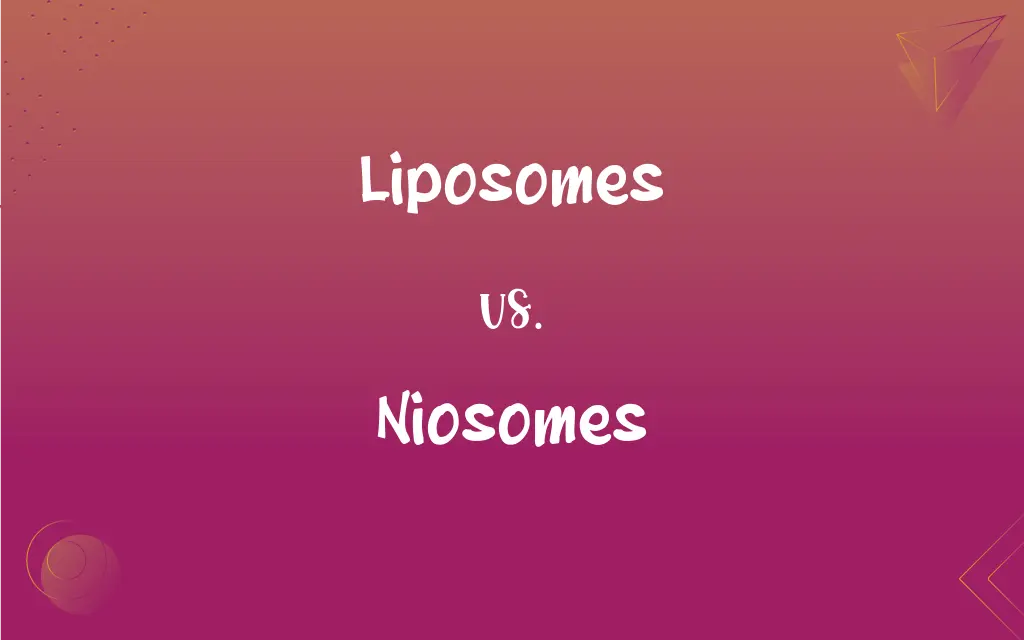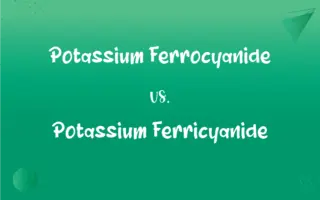Liposomes vs. Niosomes: What's the Difference?
Edited by Aimie Carlson || By Janet White || Published on January 16, 2024
Liposomes are microscopic vesicles made of lipid bilayers, used for drug delivery; niosomes are similar vesicles made of non-ionic surfactants, offering stability advantages.

Key Differences
Liposomes are tiny spherical vesicles created from cholesterol and natural non-toxic phospholipids, used primarily in drug delivery systems. Niosomes are structurally similar to liposomes but are made from non-ionic surfactants, which can make them more stable.
The primary use of liposomes is to encapsulate drugs, enhancing the delivery of substances to target areas in the body. Niosomes serve a similar purpose but are often considered more stable and less prone to oxidation than liposomes.
Liposomes can merge with cell membranes, facilitating the transfer of their encapsulated materials into cells. Niosomes, with their unique composition, also effectively deliver contents but with potentially different interaction dynamics with cell membranes.
The stability of liposomes can be affected by environmental conditions like temperature and pH. Niosomes, on the other hand, offer greater stability across a range of environmental conditions due to their synthetic surfactant composition.
Liposomes are biocompatible and biodegradable, making them suitable for medical applications. Niosomes also share these characteristics but may offer extended shelf-life and enhanced control over the release of their contents.
ADVERTISEMENT
Comparison Chart
Composition
Made of natural phospholipids and cholesterol.
Composed of non-ionic surfactants.
Stability
Prone to oxidation, sensitive to environmental changes
Generally more stable and less prone to oxidation.
Drug Delivery
Effective in drug encapsulation and delivery.
Similar drug delivery capabilities with enhanced stability.
Interaction with Cells
Can merge with cell membranes for material transfer.
Effective delivery, potentially different cell interaction.
Biocompatibility
Biocompatible and biodegradable.
Also biocompatible, with potentially longer shelf-life.
ADVERTISEMENT
Liposomes and Niosomes Definitions
Liposomes
Spherical vesicles created from natural phospholipids.
Liposomes encapsulate vitamins in skincare products for enhanced absorption.
Niosomes
Non-ionic surfactant-based vesicles used in drug delivery.
Niosomes are being researched for targeted cancer drug delivery.
Liposomes
Small vesicles made of lipid bilayers used for drug delivery.
Liposomes are used in cancer therapy to target tumor cells directly.
Niosomes
Surfactant-based carriers for controlled release of therapeutic agents.
In dermatology, niosomes deliver active compounds deeper into the skin.
Liposomes
Tiny carriers used to deliver substances to specific parts of the body.
Liposomal encapsulation is used to increase the bioavailability of oral drugs.
Niosomes
Synthetic vesicles that offer enhanced stability for encapsulated drugs.
Niosomes improve the shelf-life of certain pharmaceuticals.
Liposomes
Microscopic vesicles that can fuse with biological membranes.
In gene therapy, liposomes deliver DNA to cells.
Niosomes
Vesicular systems similar to liposomes but more resistant to oxidation.
Niosomes are used in cosmetics for sustained release of active ingredients.
Liposomes
Biodegradable vesicles suitable for encapsulating active ingredients.
Liposomes are used in vaccines to enhance immune response.
Niosomes
Structurally stable vesicles for encapsulating a variety of substances.
Niosomes enhance the solubility of poorly soluble drugs.
Liposomes
A microscopic artificial vesicle consisting of an aqueous core enclosed in phospholipid molecules, used to convey vaccines, drugs, or other substances to target tissues.
Niosomes
Plural of niosome
Liposomes
Plural of liposome
FAQs
What are niosomes?
Niosomes are vesicles similar to liposomes but made from non-ionic surfactants.
What are liposomes?
Liposomes are small vesicles made from lipid bilayers, used for drug and substance delivery.
How do liposomes work in drug delivery?
Liposomes encapsulate drugs, protecting them until they reach their target site in the body.
What makes niosomes different from liposomes in drug delivery?
Niosomes offer enhanced stability and can provide controlled release of drugs, differentiating them from liposomes.
What are the advantages of using niosomes?
Niosomes have advantages like increased stability, extended shelf-life, and controlled drug release.
Are niosomes naturally occurring?
No, niosomes are synthetically made using non-ionic surfactants.
Do niosomes protect drugs from degradation?
Yes, niosomes can protect encapsulated drugs from degradation and premature release.
Are liposomes safe for medical use?
Liposomes are generally considered safe as they are biocompatible and biodegradable.
Can liposomes be used in gene therapy?
Yes, liposomes can deliver genetic material in gene therapy applications.
How are liposomes formed?
Liposomes are formed when phospholipids in an aqueous solution arrange into bilayer spheres.
What types of drugs are suitable for liposomal delivery?
Liposomal delivery is suitable for various drugs, especially those that need targeted delivery or are sensitive to degradation.
Can liposomes carry both hydrophilic and hydrophobic drugs?
Yes, liposomes can encapsulate both hydrophilic (water-soluble) and hydrophobic (fat-soluble) drugs.
What is the size range of liposomes?
Liposomes can range in size from nanometers to several micrometers.
What is the primary use of niosomes in cosmetics?
In cosmetics, niosomes are primarily used for sustained release and improved stability of active ingredients.
Can niosomes enhance the effectiveness of skincare products?
Yes, niosomes can improve the effectiveness of skincare products by controlled release of active ingredients.
Are niosomes used in oral drug delivery?
Yes, niosomes can be used in oral drug delivery, enhancing stability and absorption.
How do niosomes compare to liposomes in cost?
Niosomes are often less costly to produce than liposomes, as they use synthetic and less expensive components.
Are liposomes used in vaccines?
Yes, liposomes are used in some vaccines to enhance immune responses.
What makes liposomes effective in targeted drug delivery?
Liposomes are effective in targeted delivery due to their ability to fuse with cell membranes and release contents at specific sites.
Can niosomes improve drug solubility?
Yes, niosomes can improve the solubility of poorly soluble drugs, enhancing their bioavailability.
About Author
Written by
Janet WhiteJanet White has been an esteemed writer and blogger for Difference Wiki. Holding a Master's degree in Science and Medical Journalism from the prestigious Boston University, she has consistently demonstrated her expertise and passion for her field. When she's not immersed in her work, Janet relishes her time exercising, delving into a good book, and cherishing moments with friends and family.
Edited by
Aimie CarlsonAimie Carlson, holding a master's degree in English literature, is a fervent English language enthusiast. She lends her writing talents to Difference Wiki, a prominent website that specializes in comparisons, offering readers insightful analyses that both captivate and inform.

































































